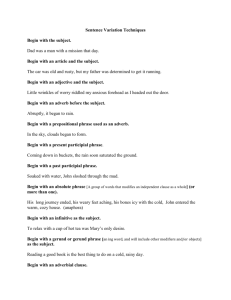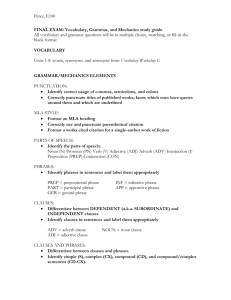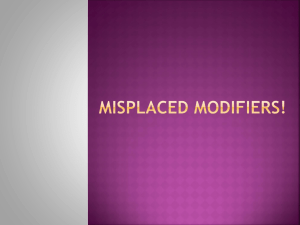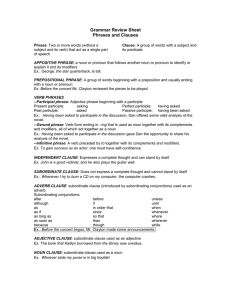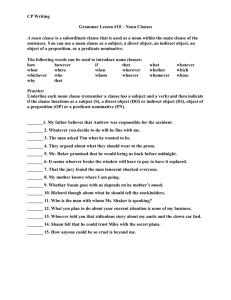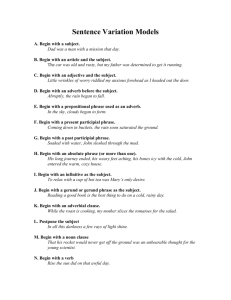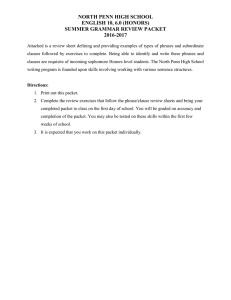51 Most Common AP Lang Terms
advertisement
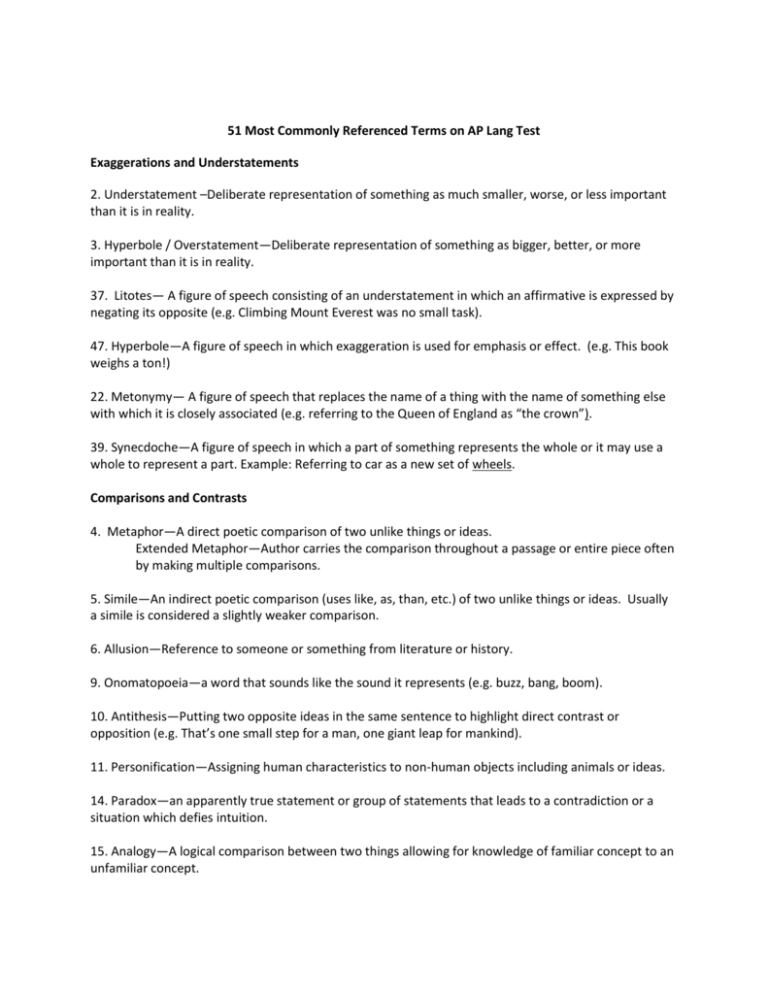
51 Most Commonly Referenced Terms on AP Lang Test Exaggerations and Understatements 2. Understatement –Deliberate representation of something as much smaller, worse, or less important than it is in reality. 3. Hyperbole / Overstatement—Deliberate representation of something as bigger, better, or more important than it is in reality. 37. Litotes— A figure of speech consisting of an understatement in which an affirmative is expressed by negating its opposite (e.g. Climbing Mount Everest was no small task). 47. Hyperbole—A figure of speech in which exaggeration is used for emphasis or effect. (e.g. This book weighs a ton!) 22. Metonymy— A figure of speech that replaces the name of a thing with the name of something else with which it is closely associated (e.g. referring to the Queen of England as “the crown”). 39. Synecdoche—A figure of speech in which a part of something represents the whole or it may use a whole to represent a part. Example: Referring to car as a new set of wheels. Comparisons and Contrasts 4. Metaphor—A direct poetic comparison of two unlike things or ideas. Extended Metaphor—Author carries the comparison throughout a passage or entire piece often by making multiple comparisons. 5. Simile—An indirect poetic comparison (uses like, as, than, etc.) of two unlike things or ideas. Usually a simile is considered a slightly weaker comparison. 6. Allusion—Reference to someone or something from literature or history. 9. Onomatopoeia—a word that sounds like the sound it represents (e.g. buzz, bang, boom). 10. Antithesis—Putting two opposite ideas in the same sentence to highlight direct contrast or opposition (e.g. That’s one small step for a man, one giant leap for mankind). 11. Personification—Assigning human characteristics to non-human objects including animals or ideas. 14. Paradox—an apparently true statement or group of statements that leads to a contradiction or a situation which defies intuition. 15. Analogy—A logical comparison between two things allowing for knowledge of familiar concept to an unfamiliar concept. Comparisons and Contrasts Cont’d 18. Allegory—In literature, the use of a narratives characters and events to represent abstract ideas or principles 19. Apostrophe—Addressing an absent or imaginary person, object, or concept as if it were the recipient of a letter or lecture. 31. Oxymoron—a figure of speech that combines two normally contradictory terms (e.g. jumbo shrimp). 51.Juxtaposition-- a literary technique in which two or more ideas, places, characters and their actions are placed side by side for the purpose of developing comparisons and contrasts. Repetitions 12. Alliteration—The repetition of the same sound at the start of several words. 16. Parallelism—The use identical or near identical syntax in corresponding phrases. 17. Parallel Structure—Using the same pattern of words to that two or more ideas have the same level of importance. General Rhetoric 1.Rhetoric – The art or study of using language effectively and persuasively. 7. Anecdote—A short account of an incident related to main point. 8. Qualify—To describe by specifying characteristics or qualities; To characterize. 13. Modes of Discourse—Narration, description, exposition, and persuasion. Narration: Relating a series of events usually in chronological order. Description: Explaining what things are like according to the five senses. Exposition: Informative writing with several subtypes including process analysis, comparison, etc Persuasion: Argument that seeks to convince an audience through logic and other means. 21. Syllogism— a formal argument in logic that is formed by two statements and a conclusion which must be true if the previous two statements are true. 32. Ambiguity—having two or more possible meanings; open to interpretation Logical Fallacies 23. Appeals to authority—Relying on testimony of an authority instead of facts. It is a logical fallacy because a testimony is neither an argument nor a fact. 38. Straw Man—a misrepresentation of an opponent’s argument that can be easily refuted or defeated 49. Circular Reasoning—a form of logical fallacy in which proposition supported by the premises, which is supported by the proposition, creating a circle in reasoning where no useful information is being shared. 50. Begging the Question—a form of logical fallacy in which a statement or claim is assumed to be true without evidence other than the statement or claim itself. Grammar 20. Dependent Clause (Subordinate Clause)—A clause that cannot stand alone as a full sentence and functions as a noun, adjective, or adverb within a sentence. 24. Sentence Types: Simple, Complex, Compound, and Complex. Simple: A sentence with one independent clause and no dependent clauses Complex: A sentence with multiple independent clauses but no dependent clauses. Compound: A sentence with one independent clause and at least one dependent clause. Complex: A sentence with multiple independent clauses and at least one dependent clause. 25. Declarative Sentences—A sentence in the form of a statement (in contrast to a command, a question, or an exclamation). Usually, declarative sentences have a subject that precedes the verb and end in a period. 27. Periodic Sentence—A sentence in which the main clause or its predicate is withheld until the end. For example: Despite heavy winds and nearly impenetrable fog, the plane landed safely. 29. Passive Voice—In a sentence using passive voice, the subject is acted upon; he or she receives the action expressed by the verb. Active voice: Julia threw the ball. Passive voice: The ball was thrown by Julia. 30. Antecedent—The word, phrase, or clause referred to by a pronoun (or pro-verb, or pro-adverb, etc). 33. Ellipses—a series of three dots indicating an intentional omission of a word, sentence, or whole section from a text without altering its original meaning. 34. Prepositional phrase—a phrase that consists of a preposition and its object. Prepositional phrases usually function as either an adverb or adjective. Adjective: The people in the house celebrated her birthday. Adverb: The book was written by him. Grammar Cont’d 41. Inversion—a literary technique in which the normal order of words is reversed in order to achieve a particular effect of emphasis or rhythm (poetic meter). In English this is most often the placement of a verb before its noun or a noun before its adjective. 43. Pronoun—A word that is used in place of a noun or noun phrase. 46. Participle Phrase-- A participle phrase is an adjective phrase that starts with a participle. Example: You could see the panther releasing its grip. Author’s Purpose 26. Elegy/Elegaic—A poem or song composed especially as a lament for a deceased person. 35. Satire—the use of humor, irony, exaggeration, or ridicule to expose and criticize people's stupidity or vices, particularly in the context of contemporary politics and other topical issues. 45. Parody—a literary or artistic work that imitates the characteristic style of an author or work for comic effect or ridicule. 48. Didactic—Writing or speech intended to teach, particularly in having moral instruction as an ulterior motive. Diction 28. Euphemism—substituting a mild, indirect, or vague term for one that is considered harsh, blunt, or offensive (e.g. Little Suzie’s goldfish passed away late last night). 36. Colloquial—Words or expressions better suited for informal conversation than formal writing. 40. Denotation-- literal or dictionary meanings of a word in contrast to its connotative or figurative meanings

